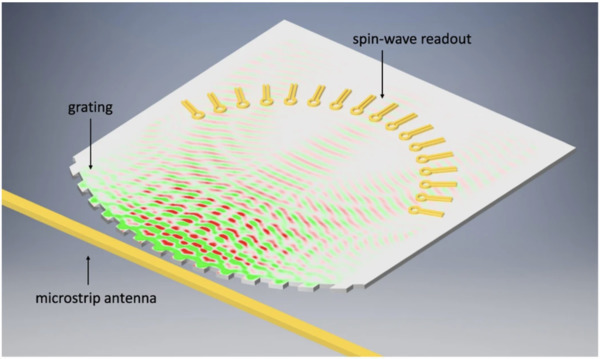Spin-Wave-Based Microwave Spectrum Analyzer
Tech ID: 16-036
Inventor: Gyorgy Csaba, Adam Papp, Jonathan Chisum, Wolfgang Porod, Gary H. Bernstein
Date Added: October 8, 2020
Overview
Microwave spectral analysis using spin-wave interference in thin magnetic films
Technology Summary

Accurately processing microwave signals is essential in research laboratories, radar receivers, and communication systems, and is a key component of 5G communication protocols. Current technologies suffer from several limitations: surface acoustic waves are limited to 5 GHz, passive filter banks and optical systems are bulky, while digital systems consume a lot of power due to requirement of high-speed analog-to-digital converters. There exists a need for a spectrum analyzer that is fast, power-efficient, high resolution, compact in size and applicable in a wide frequency range.
Researchers at the University of Notre Dame have developed a low-power, low-cost, high maximum frequency of operation, compact magnetic device for real-time spectral analysis. The main component of the device is a thin magnetic film in which the input microwave signal is injected and from which the spin waves propagate. The spin waves are deflected by the concave gratings which creates diffraction patterns and focuses the spherical waves, much like a lens would do. The frequency components of the signal become separated in the resulting inference pattern. The proposed technology utilizes the interference pattern to convert microwave input signals into electrical signals.
Market Advantages
- 2mm by 2mm size including circuitry
- Consumes a milliwatt of net power
- Wide frequency range spanning from <5 GHz to 100 GHz
- Low power and high speed
Applications
- Research laboratories
- Voice and data communications
- Radar transmitter test analysis
- Spectrum management
- Interference hunting
- Automobile radar applications
- RF sniffers
Technology Readiness Level
TRL 3 – Experimental Proof of Concept
Intellectual Property Status
US Patent 10,613,129
Publications
Nanoscale spectrum analyzer based on spin-wave interference. Doi:10.1038/s41598-017-09485-7
Contact
Richard Cox
rcox4@nd.edu
574.631.5158